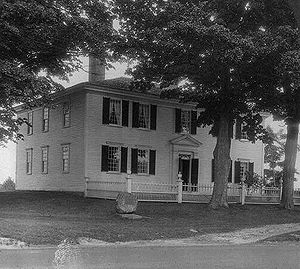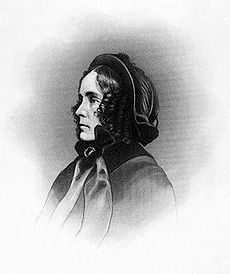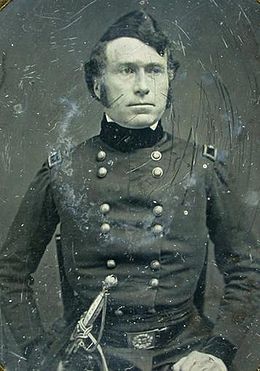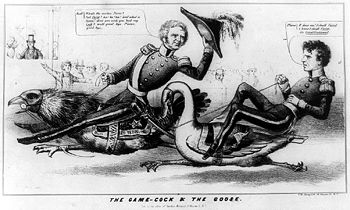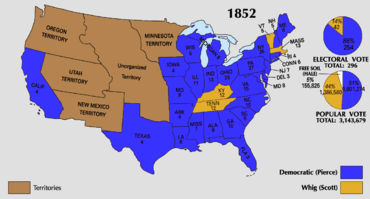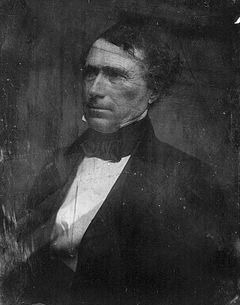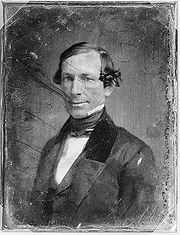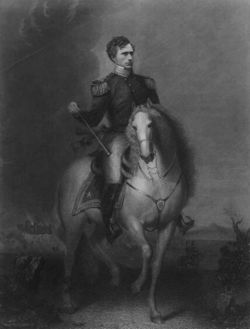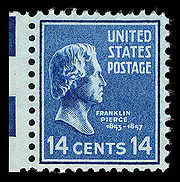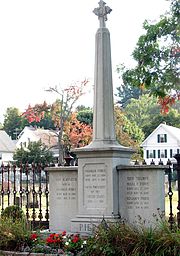
Franklin Pierce
About this schools Wikipedia selection
SOS Children, an education charity, organised this selection. Sponsoring children helps children in the developing world to learn too.
| Franklin Pierce | |
|---|---|
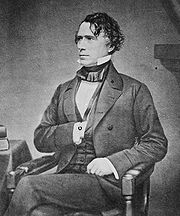 |
|
| President Pierce, about 1855, by Matthew Brady | |
| 14th President of the United States | |
| In office March 4, 1853 – March 4, 1857 |
|
| Vice President | William R. King (1853) None (1853-1857) |
| Preceded by | Millard Fillmore |
| Succeeded by | James Buchanan |
| United States Senator from New Hampshire |
|
| In office March 4, 1837 – February 28, 1842 |
|
| Preceded by | John Page |
| Succeeded by | Leonard Wilcox |
| Personal details | |
| Born | November 23, 1804 Hillsborough, New Hampshire |
| Died | October 8, 1869 (aged 64) Concord, New Hampshire |
| Nationality | United States |
| Political party | Democratic |
| Spouse(s) | Jane Appleton Pierce |
| Alma mater | Bowdoin College |
| Occupation | Lawyer |
| Religion | Episcopal |
| Signature | |
Franklin Pierce ( November 23, 1804 – October 8, 1869) was an American politician and the fourteenth President of the United States, serving from 1853 to 1857. To date, he is the only president from New Hampshire.
Pierce was a Democrat and a " doughface" (a Northerner with Southern sympathies) who served in the U.S. House of Representatives and Senate. Later, Pierce took part in the Mexican-American War and became a brigadier general. His private law practice in his home state, New Hampshire, was so successful that he was offered several important positions, which he turned down. Later, he was nominated for president as a dark horse candidate on the 49th ballot at the 1852 Democratic National Convention. In the presidential election, Pierce and his running mate William R. King won by a landslide, defeating the Whig Party ticket of Winfield Scott and William A. Graham by a 50 to 44% margin in the popular vote and 254 to 42 in the electoral vote.
His good looks and inoffensive personality caused him to make many friends, but he suffered tragedy in his personal life and as president subsequently made decisions which were widely criticized and divisive in their effects, thus giving him the reputation as one of the worst presidents in U.S. history. Pierce's popularity in the North declined sharply after he came out in favour of the Kansas-Nebraska Act, repealing the Missouri Compromise and reopening the question of the expansion of slavery in the West. Pierce's credibility was further damaged when several of his diplomats issued the Ostend Manifesto. Historian David Potter concludes that the Ostend Manifesto and the Kansas-Nebraska Act were "the two great calamities of the Franklin Pierce administration.... Both brought down an avalanche of public criticism." More important says Potter, they permanently discredited Manifest Destiny and popular sovereignty.
Abandoned by his party, Pierce was not renominated at the 1856 presidential election and was replaced by James Buchanan. After losing the Democratic nomination, Pierce continued his lifelong struggle with alcoholism as his marriage to Jane Means Appleton Pierce fell apart. His reputation was destroyed during the American Civil War when he declared support for the Confederacy, and personal correspondence between Pierce and Confederate President Jefferson Davis was leaked to the press. He died in 1869 from cirrhosis.
Philip B. Kunhardt and Peter W. Kunhardt reflected the views of many historians when they wrote in The American President that Pierce was "a good man who didn't understand his own shortcomings. He was genuinely religious, loved his wife and reshaped himself so that he could adapt to her ways and show her true affection. He was one of the most popular men in New Hampshire, polite and thoughtful, easy and good at the political game, charming and fine and handsome. However, he has been criticized as timid and unable to cope with a changing America."
Early life
Franklin Pierce was born in a log cabin near Hillsborough, New Hampshire, the second future U.S. president to be born in the Nineteenth century. The site of his birth is now under Franklin Pierce Lake. Pierce's father was Benjamin Pierce, a frontier farmer who became a Revolutionary War soldier, a state militia general, and a two-time governor of New Hampshire. His mother was Anna Kendrick. He was the sixth of eight children; he had four brothers and three sisters.
Pierce attended school at Hillsborough Centre and moved to the Hancock Academy in Hancock at the age of 11; he was transferred to Francestown Academy in the spring of 1820. Friends recalled that just after he entered the school, he became homesick and returned home on foot. His father put him into a wagon, drove him halfway back to the academy, and left him at the roadside, never saying a word. The boy trudged the remaining 7 miles back to school. Later that year he was transferred to Phillips Exeter Academy to prepare for college. In fall 1820, he entered Bowdoin College in Brunswick, Maine, where he participated in literary, political, and debating clubs.
There he met writer Nathaniel Hawthorne, with whom he formed a lasting friendship, and Henry Wadsworth Longfellow. He also met Calvin E. Stowe, Seargent S. Prentiss, and his future political rival, John P. Hale, when he joined the Athenian Society, a group of students with progressive political leanings.
In his second year of college, his grades were the lowest in his class but he worked to improve them, and graduated in 1824, third in his class. After graduation, in 1826, he entered a law school in Northampton, Massachusetts, studying under Governor Levi Woodbury, and later Judges Samuel Howe and Edmund Parker, in Amherst, New Hampshire.
He was admitted to the bar and began a law practice in Concord, New Hampshire in 1827.
Early political career
After graduating from college, Pierce entered politics and rose to a central position in the Democratic party of New Hampshire and became a member of the Concord Regency leadership group. In 1828 he was elected to the lower house of the New Hampshire General Court, the New Hampshire House of Representatives. He served in the State House from 1829 to 1833, and as Speaker from 1832 to 1833. Pierce served in the state legislature of New Hampshire while his father was governor.
In 1832, Pierce was elected as a Democrat to the 23rd and 24th Congresses ( March 4, 1833 – March 4, 1837). He was only 27 years old, the youngest U.S. Representative at the time.
In 1836, he was elected by the New Hampshire General Court as a Democrat to the United States Senate, serving from March 4, 1837, to February 28, 1842, when he resigned. He was chairman of the U.S. Senate Committee on Pensions during the 26th Congress.
After his service in the Senate, Pierce resumed the practice of law in Concord with his partner Asa Fowler. He was United States Attorney for the District of New Hampshire from 1845 to 1847. He refused the Democratic nomination for Governor of New Hampshire and also declined the appointment as Attorney General of the United States tendered by President James K. Polk.
Family
On November 19, 1834, Pierce married Jane Means Appleton (1806-63), the daughter of a former president of Bowdoin College. Appleton was Pierce's opposite. Born into an aristocratic Whig family, she was extremely shy, often ill, deeply religious, and pro- temperance. They had three children, who all died in childhood. Two of their children died very young and the last one survived until the age of 11 and was killed in a train wreck. None of them lived to see their father become president.
Jane was never happy with her husband's involvement in the political world. She hated life in Washington, D.C., and encouraged Pierce to resign his Senate seat and return to New Hampshire, which he did in 1841. After the death of her last child, shortly before Pierce's inauguration, she was overcome with melancholia and she distanced herself during her husband's presidency. Pierce's personal life caused him a great deal of pain and he was known to many as being a heavy drinker.
Franklin Pierce, Jr. ( February 2, 1836 – February 5, 1836) died three days after birth.
Frank Robert Pierce ( August 27, 1839 – November 14, 1843) died at the age of four from epidemic typhus.
Benjamin "Bennie" Pierce ( April 13, 1841 – January 16, 1853) died at the age of 11 in a tragic railway accident in Andover, Massachusetts which his parents witnessed, 1 month before the inauguration of his father.
Mexican War
He enlisted in the volunteer services during the Mexican-American War and was soon made a colonel. In March 1847, he was appointed brigadier general of volunteers and took command of a brigade of reinforcements for Winfield Scott's army marching on Mexico City. His brigade was designated the 1st Brigade in the newly created 3rd Division and joined Scott's army in time for the Battle of Contreras. During the battle he was seriously wounded in the leg when he fell from his horse.
He returned to his command the following day, but during the Battle of Churubusco, the pain in his leg became so great that he passed out and was carried from the field. His political opponents used this against him, claiming that he left the field because of cowardice instead of injury. He again returned to command and led his brigade throughout the rest of the campaign culminating in the capture of Mexico City. Although he was a political appointee, he proved to have some skill as a military commander. He returned home and served as president of the New Hampshire State constitutional convention in 1850.
Election of 1852
At the Democratic National Convention of 1852, Pierce was not initially given serious consideration for the presidential nomination. He had no credentials as a major political figure or statesman, he was not a military hero, and had not held elective office for the last ten years. The convention assembled on June 12 in Baltimore, Maryland, with four major contenders— Stephen A. Douglas, William L. Marcy, James Buchanan and Lewis Cass — for the nomination. Most of those who had left the party with Martin Van Buren to form the Free Soil Party had returned. Prior to the vote to determine the nominee, a party platform was adopted, opposing any further "agitation" over the slavery issue and supporting the Compromise of 1850 in an effort to unite the various Democratic Party factions.
When the balloting for president began, the four candidates deadlocked, with no candidate reaching even a simple majority, much less the required supermajority of two-thirds. On the 35th ballot, Pierce was put forth to break the deadlock as a compromise candidate. Pierce was generally popular due to his long career as a party activist and consistent support of Democratic positions. He had never fully articulated his views on slavery, allowing him to be acceptable to all factions. He also had served in the Mexican-American War, which allowed the party to portray him as a war hero. Pierce was nominated unanimously on the 49th ballot on June 5. Alabama Senator William R. King was chosen as the nominee for Vice President.
Pierce's opponent was the United States Whig Party candidate, General Winfield Scott of Virginia, under whom Pierce served during the Mexican-American War, and his running mate, Secretary of the Navy William A. Graham. Pierce easily prevailed as Scott — nicknamed Old Fuss and Feathers — ran a blundering campaign.
The Whigs' platform was almost indistinguishable from that of the Democrats, reducing the campaign to a contest between the personalities of the two candidates and helping to drive down voter turnout in the election to its lowest percentage level since 1836. Pierce's likable personality and lack of strongly held positions helped him prevail over Scott, whose anti-slavery views hurt him in the South. Scott's strength as a known war hero was countered by Pierce's service in the same war.
Pierce was also helped by Irish Catholic support of the Democratic Party and disdain for the Whig Party.
The Democrats' slogan was "We Polked you in 1844; we shall Pierce you in 1852!" (a reference to the victory of James K. Polk in the 1844 election). This proved to be true, as Scott only won the states of Kentucky, Tennessee, Massachusetts, and Vermont. The total popular vote was 1,601,274 to 1,386,580, or 50.9% to 44.1%. Pierce won 27 of the 31 states, including Scott's home state of Virginia. John P. Hale, who like Pierce was from New Hampshire, was the nominee of the remnants of the Free Soil Party, garnering 155,825 votes (5% of the total).
The election of 1852 would be the last presidential contest in which the Whigs would field a candidate. In 1854, the Kansas-Nebraska Act divided the Whigs, with the Northern Whigs deeply opposed. As a result, the Whigs splintered and most of their membership migrated to the nativist American Party Know-Nothings, the Constitutional Union Party, and the newly formed Republicans.
At his inauguration, Pierce was the youngest President ever, age 48, a record he would keep until 46-year-old Ulysses S. Grant was inaugurated president in 1869.
Results of the election: Pierce/King: 254 electoral votes, 1.6 million popular votes Scott/Graham: 42 electoral votes, 1.3 million popular votes Hale/Julian: 0 electoral votes, 155,000 popular votes.
Presidency 1853-1857
Beginnings
Franklin Pierce assumed presidency at a time of relative tranquility and peace. The Compromise of 1850 seemed to have calmed the storm around the issue of slavery. When the issue suddenly resurfaced during his administration, however, Pierce did little to deal with it and the sectional fissures reopened. He was able to follow in the footsteps of previous party presidents because he was committed to the same causes they were and because other party member saw the virtues of the qualities he possessed. Pierce served as U.S. President from March 4, 1853, to March 4, 1857. Two months before he took office on January 6, 1853, shortly after boarding a train in Boston, president-elect Pierce and his family were trapped in a derailed car when it rolled over an embankment near Andover, Massachusetts. Pierce and his wife survived and were merely shaken up, but they watched as their 11-year-old son Benjamin ("Bennie") was crushed to death. Grief-stricken, Pierce entered the presidency nervously exhausted.
The family had already lost two children to typhus, and Jane Pierce believed the train accident was divine punishment for her husband's acceptance of the high office of the presidency. Other events deepened the somber mood of the new administration: former First Lady Abigail Fillmore's death in March and that of Vice President William R. King in April. As a result, Pierce chose to " affirm" his Oath of Office on a law book rather than the Bible. He is among a small number of Presidents who did not take the presidential oath on a Bible. (As an example,Theodore Roosevelt did not place his hand on anything at all). In his inaugural address, Pierce proclaimed an era of peace and prosperity at home and vigor in relations with other nations, saying that the United States might have to acquire additional possessions for the sake of its own security and would not be deterred by "any timid forebodings of evil."
Policies
Pierce selected for his Cabinet not men of similar beliefs but a broad cross-section of people he personally knew and of the Democratic Party itself. Many thought that the diverse group would soon break up, but instead it became the only Cabinet, as of 2008, that remained unchanged through a four-year term. In foreign policy, Pierce showed a traditional Democratic assertiveness. When Pierce came into office, there were significant tensions with a weak Spain, a reclusive Japan, and a powerful Britain creating problems in Central America. Just as in domestic affairs, Pierce's leadership came into question because he seemed to be too overwhelmed by forces he could not control.
Pierce aroused sectional apprehension when he pressured the United Kingdom to relinquish its special interests along part of the Central American coast, and when he tried to persuade Spain to sell Cuba for $100 million (USD) because of the expansive sugar crop in Cuba.
The release of the Ostend Manifesto, signed by several of Pierce's cabinet members, caused outrage with its suggestion that the U.S. seize Cuba by force, and permanently discredited the Democratic Party's expansionist policies, which it had so famously ridden to victory in 1844.

An 1856 cartoon depicts a giant free soiler being held down by James Buchanan and Lewis Cass standing on the Democratic platform marked " Kansas", "Cuba" and "Central America". President Pierce also holds down the giant's beard as Stephen A. Douglas shoves a black man down his throat.
But the most controversial event of Pierce's presidency was the Kansas-Nebraska Act, which repealed the Missouri Compromise and reopened the question of slavery in the West. This measure, the handiwork of Senator Stephen A. Douglas, allegedly grew out of his desire to promote a railroad from Chicago, Illinois to California through Nebraska. This problem came as much of a surprise to Pierce and the rest of his party members since they had spent a great deal of time calming down and fixing the difficult sectional tension. The party leaders thought they had succeeded in doing this with measures like the Compromise of 1850.
Secretary of War Jefferson Davis, advocate of a southern transcontinental route, had persuaded Pierce to send James Gadsden to Mexico to buy land for a southern railroad. He purchased the area now comprising southern Arizona and part of southern New Mexico for $10 million (USD), commonly known as the Gadsden Purchase. This became known as the greatest success of the Pierce presidency.
Douglas, to win Southern support for the organization of Nebraska, placed in his bill a provision declaring the Missouri Compromise null and void. Douglas provided in his bills that the residents of the new territories could decide the slavery question for themselves. Pierce, who, in the eyes of his opponents, had acquired a reputation as untrustworthy and easily manipulated, was persuaded to support Douglas' plan in a closed meeting between Pierce, Douglas, and several southern Senators, with Pierce consulting only Jefferson Davis of his cabinet.
The passage of the Kansas-Nebraska Act brought about a sequence of events that developed into Bleeding Kansas. Pro-slavery Border Ruffians, mostly from Missouri, illegally voted in a government that Pierce recognized, and Pierce called the Topeka Constitution, a shadow government set up by Free-Staters, an act of "rebellion." Pierce continued to recognize the pro-slavery legislature even after a congressional investigative committee found its election illegitimate. He furthermore sent in federal troops to break up a meeting of the shadow government in Topeka.
The Act also caused widespread outrage in the North and spurred the creation of the Republican Party, a sectional Northern party which was organized as a direct response to the bill. The election of Republican Abraham Lincoln would lead to declarations of secession in 1860 and 1861.
Meanwhile, Pierce lost all credibility he may have had in the North, and, as of 2008, was the only elected president (rather than a Vice President who succeeded to the position) to fail to be renominated by his party for a second term. Pierce is ranked among the least effective Presidents as well as an indecisive politician who was easily influenced. He was unable to command as President or to provide the required national leadership. Yet, he had the courage to stand by his convictions and buck the will of is own party, leading to his political exile.
Major legislation signed
- Signed Kansas-Nebraska Act.
Administration and Cabinet
| The Pierce Cabinet | ||
|---|---|---|
| Office | Name | Term |
| President | Franklin Pierce | 1853–1857 |
| Vice President | William R. King | 1853 |
| None | 1853–1857 | |
| Secretary of State | William L. Marcy | 1853–1857 |
| Secretary of Treasury | James Guthrie | 1853–1857 |
| Secretary of War | Jefferson Davis | 1853–1857 |
| Attorney General | Caleb Cushing | 1853–1857 |
| Postmaster General | James Campbell | 1853–1857 |
| Secretary of the Navy | James C. Dobbin | 1853–1857 |
| Secretary of the Interior | Robert McClelland | 1853–1857 |
Supreme Court appointments
Pierce appointed the following Justices to the Supreme Court of the United States:
- John Archibald Campbell – 1853
States admitted to the Union
none
Later life
After losing the Democratic nomination, Pierce reportedly quipped "there's nothing left to do but get drunk" (quoted also as "after the White House what is there to do but drink?") which he apparently did frequently. He once ran over an elderly woman while driving a carriage. During the Civil War, Pierce further damaged his reputation in the North by declaring support for the Confederacy, headed by his old cabinet member Davis. One of the few friends to stick by Pierce was his college friend and biographer, Nathaniel Hawthorne, although the former president had fallen so low that he was not asked to stand as a pallbearer at Hawthorne's funeral.
In 1863 during the aftermath of Vicksburg, Union Soldiers under General Hugh Ewing's command captured Confederate President Jefferson Davis' Fleetwood Plantation, and Ewing turned over Davis' personal correspondence to his brother-in-law William T. Sherman. However, Ewing also sent copies of the letters to a few people he had known in Ohio, which, after being published, permanently ruined the reputation of former President Pierce.As early as 1860, Pierce had written to Davis about "the madness of northern abolitionism," and other letters uncovered stated that he would "never justify, sustain, or in any way or to any extent uphold this cruel, heartless, aimless unnecessary war", and that "the true purpose of the war was to wipe out the states and destroy property." His reputation was destroyed in the eyes of his enemies. Abolitionist author Harriet Beecher Stowe referred to him as "the archtraitor."
Franklin Pierce died in Concord, New Hampshire at 4:49 a.m. on October 8, 1869 at 64 years old, from cirrhosis of the liver, stemming from his heavy drinking problem that he carried throughout his life, and was interred in the Minot Enclosure in the Old North Cemetery of Concord. Historically he is known to Northerners as one of America's worst and most unproductive presidents, and to many Southern sympathizers as a fair and friendly chief executive who could not manage the events that were beyond his or anyone else's control.
Legacy
Places named after President Pierce:
- Franklin Pierce University in Rindge, New Hampshire.
- Franklin Pierce School District, and namesake high school in Parkland, Washington
- Pierce Elementary School in Flint, Michigan.
- Franklin Pierce High School in the South Central Los Angeles
- Pierce County in Washington, Nebraska, Georgia, and Wisconsin (But not in North Dakota)
- Franklin Pierce Law Centre in Concord, New Hampshire
- Mt. Pierce in the Presidential Range of the White Mountains, New Hampshire
- Pierce Street in downtown Amarillo, Texas
- Pierce Road in the presidential roads in Weymouth, Massachusetts
- Franklin Pierce Caverns (located in southern Illinois)
Preserved home
- Franklin Pierce Homestead now a New Hampshire state park
